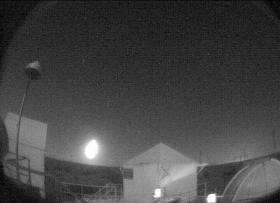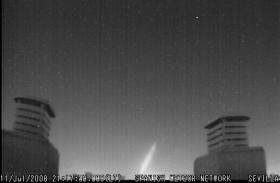How a cometary boulder lit up the Spanish sky

(PhysOrg.com) -- Last July, people in Spain, Portugal and France watched the brilliant fireball produced by a boulder crashing down through the Earth’s atmosphere. In a paper to be published in the journal Monthly Notices of the Royal Astronomical Society, astronomers Josep M. Trigo-Rodríguez (Institute of Space Sciences, CSIC-IEEC, Spain), José M. Madiedo (University of Huelva-CIECEM, Spain) and Iwan P. Williams (Queen Mary, University of London) present dramatic images of this event. The scientists go on to explain how the boulder may originate from a comet which broke up nearly 90 years ago and suggest the tantalising possibility that chunks of the boulder (and hence pieces of the comet) are waiting to be found on the ground.
Fireballs (or bolides) are the name given by astronomers to the brightest meteors (popularly referred to as ‘shooting stars’). On 11th July 2008, at 2117 GMT, a brilliant fireball was recorded. At maximum intensity, the object was more than 150 times as bright as the full Moon. It was first picked up at a height of 98.3 km and disappeared from view 21.5 km above the surface of the Earth, tracked by three stations of the Spanish Fireball Network (SPMN) above Bejar, near Salamanca in Spain. At the same time a professional photographer took a picture of the bolide from the north of Madrid.
From these images, the astronomers can deduce the trajectory and properties of the incoming boulder. The team think it was a dense object, about 1 metre across and with a mass of 1.8 tonnes, large enough that some fragments probably survived intact and fell to the ground as meteorites.
The astronomers demonstrate that before its fiery demise, the boulder travelled on an unusual orbit around the Sun, on a path which took it from beyond the orbit of Jupiter to the vicinity of the Earth. This orbit is very similar to that of a cloud of dusty particles (meteoroids) known as the Omicron Draconids, which on rare occasions produces a minor meteor shower and probably originates from the breakup of Comet C/1919 Q2 Metcalf in 1920. This strongly suggests that the boulder was once embedded in the nucleus of that comet.

In the mid-1980s the astronomers Tamas I. Gombosi and Harry L.F. Houpis first suggested that the nuclei of comets consist of relatively large boulders cemented together by a ‘glue’ of smaller particles and ice. If the rocky and icy nucleus of a comet disintegrates, then these large boulders are set loose into space. If the Bejar bolide was formed in this way, then it confirms the glue model for at least some comets.
And if fragments of the bolide can be recovered, then for the first time, scientists will be able to study large pieces from a comet in a laboratory. Dr Trigo-Rodríguez comments “If we are right, then by monitoring future encounters with other clouds of cometary debris, we have the chance to recover meteorites from specific comets and analyse them in a lab. Handling pieces of comet would fulfil the long-held ambitions of scientists - it would effectively give us a look inside some of the most enigmatic objects in the Solar System."
More information: The paper will be published in Monthly Notices of the Royal Astronomical Society. The abstract is available online at www3.interscience.wiley.com/jo … ct?CRETRY=1&SRETRY=0
Provided by Royal Astronomical Society





















